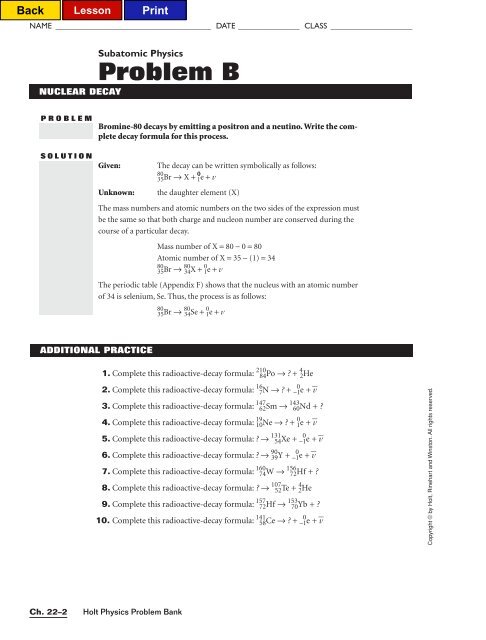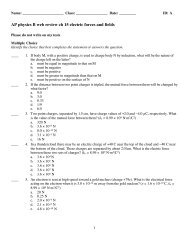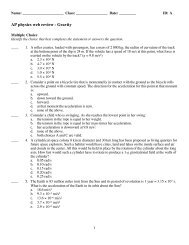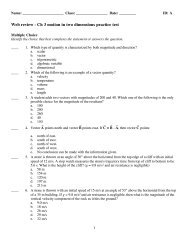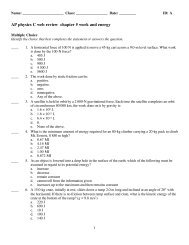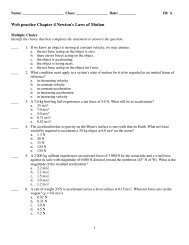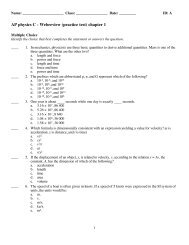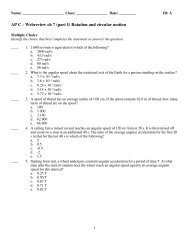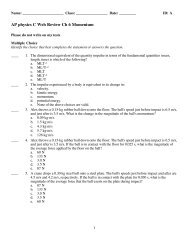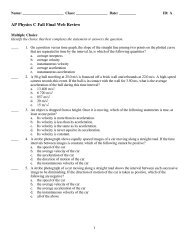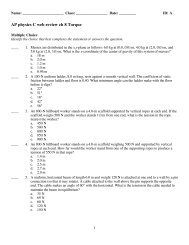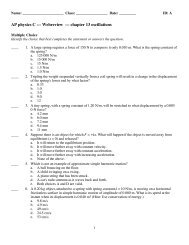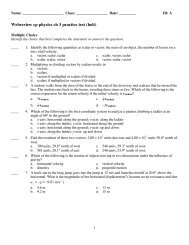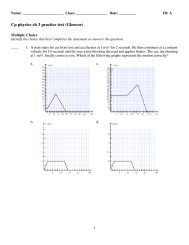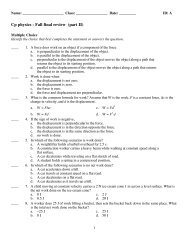Problem B Copyright reserved
nuclear decay 2 - Planet Holloway
nuclear decay 2 - Planet Holloway
Create successful ePaper yourself
Turn your PDF publications into a flip-book with our unique Google optimized e-Paper software.
NAME ______________________________________ DATE _______________ CLASS ____________________<br />
Subatomic Physics<br />
<strong>Problem</strong> B<br />
NUCLEAR DECAY<br />
PROBLEM<br />
SOLUTION<br />
Bromine-80 decays by emitting a positron and a neutino. Write the complete<br />
decay formula for this process.<br />
Given:<br />
Unknown:<br />
The decay can be written symbolically as follows:<br />
80<br />
35 Br → X + 0 1 e + v<br />
the daughter element (X)<br />
The mass numbers and atomic numbers on the two sides of the expression must<br />
be the same so that both charge and nucleon number are conserved during the<br />
course of a particular decay.<br />
Mass number of X = 80 − 0 = 80<br />
Atomic number of X = 35 − (1) = 34<br />
80<br />
35 Br → 80<br />
34X + 1e 0 + v<br />
The periodic table (Appendix F) shows that the nucleus with an atomic number<br />
of 34 is selenium, Se. Thus, the process is as follows:<br />
80<br />
35 Br → 80 34Se + 1e 0 + v<br />
ADDITIONAL PRACTICE<br />
1. Complete this radioactive-decay formula: 210 84Po → ? + 4 2He<br />
2. Complete this radioactive-decay formula: 16 7N → ? + –1<br />
0 e + v <br />
3. Complete this radioactive-decay formula: 147 62Sm → 143 60Nd + ?<br />
4. Complete this radioactive-decay formula: 19 10Ne → ? + 1e 0 + v<br />
5. Complete this radioactive-decay formula: ? → 131 54Xe + –1<br />
0 e + v <br />
6. Complete this radioactive-decay formula: ? → 90<br />
39Y + –1<br />
0 e + v <br />
7. Complete this radioactive-decay formula: 160<br />
74W → 156 72Hf + ?<br />
8. Complete this radioactive-decay formula: ? → 107 52Te + 2He<br />
4<br />
9. Complete this radioactive-decay formula: 157 72Hf → 153 70Yb + ?<br />
10. Complete this radioactive-decay formula: 141 58Ce → ? + –1<br />
0 e + v <br />
<strong>Copyright</strong> © by Holt, Rinehart and Winston. All rights <strong>reserved</strong>.<br />
Ch. 22–2<br />
Holt Physics <strong>Problem</strong> Bank
Givens<br />
8. A = 64<br />
Z = 30<br />
atomic mass of zinc-64<br />
= 63.929 144 u<br />
atomic mass of H<br />
= 1.007 825 u<br />
m n = 1.008 665 u<br />
Solutions<br />
N = A − Z = 64 − 30 = 34<br />
∆m = Z(atomic mass of H) + Nm n − atomic mass of zinc-64<br />
∆m = 30(1.007 825 u) + 34(1.008 665 u) − 63.929 144 u<br />
∆m = 30.234 750 u + 34.294 610 u − 63.929 144 u<br />
∆m = 0.600 216 u<br />
9. A = 90<br />
Z = 40<br />
atomic mass of zirconium-90<br />
= 89.904 702 u<br />
atomic mass of H<br />
= 1.007 825 u<br />
m n = 1.008 665 u<br />
N = A − Z = 90 − 40 = 50<br />
∆m = Z(atomic mass of H) + Nm n − atomic mass of zirconium-90<br />
∆m = 40(1.007 825 u) + 50(1.008 665 u) − 89.904 702 u<br />
∆m = 40.313 000 u + 50.433 250 u − 89.904 702 u<br />
∆m = 0.841 548 u<br />
E bind = (0.841 548 u)(931.49 MeV/u) = 783.89 MeV<br />
10. A = 32<br />
Z = 16<br />
atomic mass of sulfur-32<br />
= 31.972 071 u<br />
atomic mass of H<br />
= 1.007 825 u<br />
m n = 1.008 665 u<br />
N = A − Z = 32 − 16 = 16<br />
∆m = Z(atomic mass of H) + Nm n − atomic mass of sulfur-32<br />
∆m = 16(1.007 825 u) + 16(1.008 665 u) − 31.972 071 u<br />
∆m = 16.125 200 u + 16.138 640 u − 31.972 071 u<br />
∆m = 0.291 769 u<br />
Additional Practice B<br />
<strong>Copyright</strong> © by Holt, Rinehart and Winston. All right <strong>reserved</strong>.<br />
1. 210<br />
84 Po → ? + 2He 4 A = 210 − 4 = 206<br />
Z = 84 − 2 = 82<br />
? = 206<br />
82 Pb<br />
2. 16 7 N → ? + −1e 0 + v A = 16 − 0 = 16<br />
Z = 7 − (−1) = 8<br />
? = 16 8 O<br />
3. 147<br />
62 Sm → 143<br />
60 Nd + ? + v A = 147 − 143 = 4<br />
Z = 62 − 60 = 2<br />
? = 4 2 He<br />
4. 19<br />
10 Ne → ? + 0 1e + v A = 19 − 0 = 19<br />
Z = 10 − 1 = 9<br />
? = 19 9 F<br />
V<br />
Section Five—<strong>Problem</strong> Bank V Ch. 22–3
Givens<br />
Solutions<br />
5. ? → 131<br />
54 Xe + −1e 0 + v A = 131 + 0 = 131<br />
Z = 54 + (−1) = 53<br />
? = 131<br />
53 I<br />
6. ? → 90<br />
39 Y + −1e 0 + v A = 90 + 0 = 90<br />
Z = 39 + (−1) = 38<br />
? = 90<br />
38 Sr<br />
7. 160<br />
74 W → 156<br />
72 Hf + ? A = 160 − 156 = 4<br />
Z = 74 − 72 = 2<br />
4<br />
? = 2 He<br />
8. ? → 107<br />
52 Te + 4 2He A = 107 + 4 = 111<br />
Z = 52 + 2 = 54<br />
? = 111<br />
54 Xe<br />
9. 157<br />
72 Hf → 153<br />
70 Yb + ? A = 157 − 153 = 4<br />
Z = 72 − 70 = 2<br />
? = 4 2 He<br />
10. 141<br />
58 Ce → ? + −1e 0 + v A = 141 − 0 = 141<br />
Z = 58 − (−1) = 59<br />
? = 141<br />
59 Pr<br />
Additional Practice C<br />
1. m i = 5.25 × 10 −3 g<br />
m f = 3.28 × 10 −4 g<br />
∆t = 12 h<br />
2. m i = 3.29 × 10 −3 g<br />
m f = 8.22 × 10 −4 g<br />
∆t = 30.0 s<br />
3. m i = 4.14 × 10 −4 g<br />
m f = 2.07 × 10 −4 g<br />
∆t = 1.25 days<br />
mf<br />
⎯⎯ =⎯ 3 −4<br />
. 28<br />
× 10<br />
g 1<br />
⎯ −3<br />
= ⎯⎯<br />
mi<br />
5.<br />
25<br />
× 10<br />
g 1 6<br />
1<br />
If ⎯⎯ 1<br />
of the sample remains after 12 h, then ⎯ 1 6<br />
8 ⎯ of the sample must have remained after<br />
6.0 h, ⎯ 1 4 ⎯ of the sample must have remained after 3.0 h, and ⎯ 1 2 ⎯ of the sample must have<br />
remained after 1.5 h. So T 1/2 = 1.5 h<br />
mf<br />
⎯⎯ =⎯ 8 −4<br />
. 22<br />
× 10<br />
g<br />
⎯ −3<br />
= ⎯ 1<br />
mi<br />
3.<br />
29<br />
× 10<br />
g 4 ⎯<br />
If ⎯ 1 4 ⎯ of the sample remains after 30.0 s, then ⎯ 1 2 ⎯ of the sample must have remained after<br />
15.0 s, so T 1/2 = 15.0 s .<br />
mf<br />
⎯⎯ = ⎯ 2 −4<br />
. 07<br />
× 10<br />
g<br />
⎯ −4<br />
= ⎯ 1<br />
mi<br />
4.<br />
14<br />
× 10<br />
g 2 ⎯<br />
If ⎯ 1 2 ⎯ of the sample remains after 1.25 days, then T 1/2 = 1.25 days<br />
<strong>Copyright</strong> © by Holt, Rinehart and Winston. All right <strong>reserved</strong>.<br />
V<br />
V Ch. 22–4<br />
Holt Physics Solutions Manual


